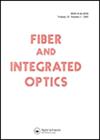基于二维光子晶体均匀环形谐振器的两个8通道光解复用器的设计
IF 2.3
4区 物理与天体物理
Q2 OPTICS
引用次数: 19
摘要
环形谐振器一直被认为是设计光学器件的一种高度灵活的结构。在本文中,我们设计并评估了两个使用光子晶体环形谐振器的8通道光解复用器。本研究的目的是探讨这种谐振器在设计和制造基于光子晶体的光学器件方面的灵活性。就我们调查的文献而言,到目前为止还没有这样的研究报告。为此,使用具有相同结构参数的两个结构,但仅在晶格常数类型(正方形或三角形)上有所不同。这两种结构在适当范围内具有共同的光子带隙,用于波分复用(WDM)系统的电信应用。两种设计结构的平均串扰均为−26 dB。对于方形晶格常数解复用器结构,其品质因子和传输系数分别为3046和93.7%,通道间距为1.97 nm。对于三角形晶格常数结构,其品质因子和透射系数分别为1577.7和94.5%,通道间距为4 nm。利用平面波展开法(PWE)获得结构的光子带隙,利用时域有限差分法(FDTD)获得结构的输出谱。本研究仅通过改变所使用的晶格常数类型来设计和模拟光解复用器结构,从而获得了良好的结果。这无疑证明了环形谐振器在光学器件设计中的高灵活性,以及它们在WDM系统中的适用性本文章由计算机程序翻译,如有差异,请以英文原文为准。
Design of Two 8-Channel Optical Demultiplexers Using 2D Photonic Crystal Homogeneous Ring Resonators
ABSTRACT Ring resonators have always been referred to as a highly flexible structure for designing optical devices. In this paper, we have designed and evaluated two 8-channel optical demultiplexers using photonic crystal ring resonators. The purpose of this study is to investigate the flexibility of this type of resonator for designing and manufacturing optical devices based on photonic crystals. To the extent that we have investigated the literature, there is no report so far on such a study. For this purpose, two structures with the same structural parameters, but only with a difference in the type of lattice constant (square or triangular) are used. Both structures have a common photonic band gap within a proper range for telecommunication applications used in wavelength-division multiplexing (WDM) systems. Both designed structures have an average crosstalk of −26 dB. For the demultiplexer structure with a square lattice constant, the quality factor and the transmission coefficient are 3,046 and 93.7% respectively, and its channel spacing is 1.97 nm. For the structure with a triangular lattice constant, the quality factor and the transmission coefficient are 1577.7 and 94.5%, respectively and its channel spacing is equal to 4 nm. To obtain the photonic band gap of the structures, the plane wave expansion (PWE) method is used and the output spectrum of the structures is obtained using the finite-difference time-domain (FDTD) method. The good results obtained in this study is through designing and simulating optical demultiplexer structures only by creating a change in the type of lattice constant used. This undoubtedly justifies the high flexibility of ring resonators, when used in the design of optical devices, as well as their suitability for the use in WDM systems
求助全文
通过发布文献求助,成功后即可免费获取论文全文。
去求助
来源期刊
CiteScore
3.40
自引率
0.00%
发文量
4
审稿时长
>12 weeks
期刊介绍:
Fiber and Integrated Optics , now incorporating the International Journal of Optoelectronics, is an international bimonthly journal that disseminates significant developments and in-depth surveys in the fields of fiber and integrated optics. The journal is unique in bridging the major disciplines relevant to optical fibers and electro-optical devices. This results in a balanced presentation of basic research, systems applications, and economics. For more than a decade, Fiber and Integrated Optics has been a valuable forum for scientists, engineers, manufacturers, and the business community to exchange and discuss techno-economic advances in the field.

 求助内容:
求助内容: 应助结果提醒方式:
应助结果提醒方式:


